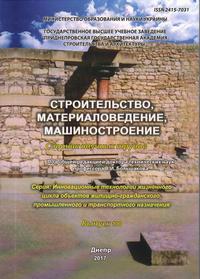Study of behavior of flexible rods as a part of the steel and concrete composite cable space frame
Keywords:
structure, steel and concrete composite construction, roof, stress-strain state, module, flexible rodAbstract
Abstract. Purpose. Steel and concrete composite cable space frame is double-layer roof system, consisting of spatial modules, connected to each other via bolted joints. The shaping of the structure is made through the flexible elements of the bottom chord, which are manufactured as cables. Taking into account the fact that the steel and concrete composite cable space frame is a completely new type of structure with the original design, then the investigation of the stress-strain state of individual elements of the structure is a pressing issue. Therefore, the purpose of the work is to determine the specifics of the behavior and study the stressstrain state of flexible rod elements of the bottom chord that are a part of the new steel and concrete composite cable space frame assembled from the spatial modules via bolted joints. Methodology. To design and produce an experimental full-size sample of the steel and concrete composite cable space frame. Experimentally determine the specifics of the behavior and the nature of deformation of the flexible elements of the bottom chord of the new steel and concrete composite cable space frame under a uniformly distributed load. Measurement of deformations was carried out by using strain gauges. The location of the strain gauges was carried out in the most characteristic sections of the investigated elements of the structure. According to the results of the experiment, the conclusion is drawn about the effectiveness of the constructive solution of the designed structure and the accepted method of ensuring the joint operation of the components of the structure. The obtained experimental data are compared with the results of theoretical investigations. . Findings. The efficiency of the constructive solution and the adopted method for ensuring the joint operation of the components of the structure was confirmed. The peculiarities of the operation of flexible elements of the bottom chord as part of the space structure are established. The dependence of deformation of the investigated elements on the level of loading was established. Originality. It is defined the stress-strain state of the flexible elements of the bottom chord of the new steel and concrete composite cable space frame. Practical value. Studying of the specifics of the operation and the stress-strain state of individual bearing elements of the structure enabled to confirm the effectiveness of the proposed constructive solution and the method of ensuring the joint operation of the modular elements. That, in turn gives impetus to the further solving the general issue and overcoming the obstacle to the introduction of new structure into the construction practice.References
Gasii G., Hasii O., and Zabolotskyi O. Estimate of technical and economic benefits of a new space composite structure. MATEC Web of Conferences, 2017, vol. 116, pp. 02014. doi: 10.1051/matecconf/201711602014.
Gasii G.M. Types of steel and concrete composite cable space frames. Science and Transport Progress. Bulletin of Dnipropetrovsk National University of Railway Transport, 2016, 6 (66), pp. 158–165. doi: 10.15802/stp2016/90514.
Ivanyk І., Vybranets Y., and Ivanyk Y. Research of composite combined prestressed constructions. Czasopismo naukowe Acta. Architectura Budownictwo, 2014, 13 (2), pp. 81–88.
Krasnov S.N., and Krasnova K.S. Creation of a new pedestrian bridge structure. Collection of scientific works: Innovative Processes and Technologies. Ways of their implementation in automobile, road-building, transport, nature protection and education fields. Kharkov: KhNAHU, 2013, pp. 250–254.
Oehlers D.J., and Bradford M.A. Composite Steel and Concrete Structures: Fundamental Behavior. Elsevier, 2013, 588 p.
Shmukler V., Kislov A., Krasnova E., and Petrova E. The forming of an efficient construction of a pedestrian bridge. Proceedings of the 15th Conference for Lithuania Junior Researchers SCIENCE – FUTURE OF LITHUANIA. Vilnius, Lithuania, 2012, pp. 250–254.
Uy B. Applications, behaviour and design of composite steel-concrete structures. Advances in Structural Engineering., 2012, vol. 15, iss. 9, pp. 1559–1572.
Shariati A., Ramli S.N.H., Suhatril M., and Shariati M. Various types of shear connectors in composite structures: a review. International Journal of Physical Sciences, 2012, vol. 7, iss. 22, pp. 2876–2890.
Wang C.M., Zhao X., and Wu M. Application of Steel Bar Truss Deck Construction Technology in a Large Steel Project. In Applied Mechanics and Materials, 2013, vol. 368, pp. 851–854.
Wong H.T. Behaviour and modelling of steel-concrete composite shell roofs: PhD Thesis. Hong Kong: The Hong Kong Polytechnic University, 2005, 420 p.
Downloads
Published
Issue
Section
License
Редакція Видання категорично засуджує прояви плагіату в статтях та вживає всіх можливих заходів для його недопущення. Плагіат розглядається як форма порушення авторських прав і наукової етики.
При виявлені у статті більш ніж 25% запозиченого тексту без відповідних посилань та використання лапок, стаття кваліфікується як така, що містить плагіат. У цьому випадку стаття більше не розглядається редакцією, а автор отримує перше попередження.
Автори, в статтях яких повторно виявлено плагіат, не зможуть публікуватися в усіх журналах Видавництва ДВНЗ «Придніпровська державна академія будівництва та архітектури».
Автори, які публікуються у цьому журналі, погоджуються з наступними умовами:
- Автори залишають за собою право на авторство своєї роботи та передають журналу право першої публікації цієї роботи на умовах ліцензії Creative Commons Attribution License, котра дозволяє іншим особам вільно розповсюджувати опубліковану роботу з обов'язковим посиланням на авторів оригінальної роботи та першу публікацію роботи у цьому журналі.
- Автори мають право укладати самостійні додаткові угоди щодо неексклюзивного розповсюдження роботи у тому вигляді, в якому вона була опублікована цим журналом (наприклад, розміщувати роботу в електронному сховищі установи або публікувати у складі монографії), за умови збереження посилання на першу публікацію роботи у цьому журналі.
- Політика журналу дозволяє і заохочує розміщення авторами в мережі Інтернет (наприклад, у сховищах установ або на особистих веб-сайтах) рукопису роботи, як до подання цього рукопису до редакції, так і під час його редакційного опрацювання, оскільки це сприяє виникненню продуктивної наукової дискусії та позитивно позначається на оперативності та динаміці цитування опублікованої роботи (див. The Effect of Open Access).

